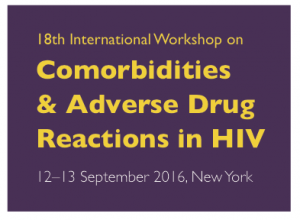Exercise associated with significantly reduced risk of serious health problems and higher CD4 counts in large multicentre US study
1 October 2016. Related: Conference reports, Research studies, Lipodystrophy Workshop (IWADRH) 18 New York 2016.
 Simon Collins, HIV i-Base
Simon Collins, HIV i-Base
A large US study in over 11,000 people living with HIV reported significant benefits of exercise. [1]
These benefits included higher CD4 counts, better lipid and glucose levels and reduced incidence of heart disease and other comorbidities.
This was a prospective, longitudinal, multi-centre study, with more than 40,000 individual assessments of physical activity (PA). Approximately 11,000 people in the study had at least one assessment, with more than 8,000 people having two and more than 800 people having at least five reports.
 This was a representative cohort, with approximate baseline characteristics including mean age 43 years old (range 19 to 82), approximately 80% male and 2% transgender. Roughly one-third were African American and 15% Hispanic. Mean CD4 count and viral load was >500 cells/mm3 (+/- 280) and <200 copies/mL (+/- 1.2 log) respectively and mean weight and BMI was about 81 kg and 26.5 kg/m2 (+/- 5).
This was a representative cohort, with approximate baseline characteristics including mean age 43 years old (range 19 to 82), approximately 80% male and 2% transgender. Roughly one-third were African American and 15% Hispanic. Mean CD4 count and viral load was >500 cells/mm3 (+/- 280) and <200 copies/mL (+/- 1.2 log) respectively and mean weight and BMI was about 81 kg and 26.5 kg/m2 (+/- 5).
Self-defined levels at baseline showed than more than two-thirds of the cohort had low or very low levels of PA: 26% very low (n=3058), 42% low (n=4957), 19% moderate (n=2177) and 13% high (n=1527).
Factors associated at baseline with levels of activity that were significantly lower included being women, transgender, heavier and African American; with lower CD4 counts and higher BMI, all P<0.05). Levels of HDL cholesterol were higher with lower triglycerides and fasting blood glucose.
In the multivariate longitudinal analysis, after adjusting for site, age, race, sex, insurance status, transmission risk, tobacco history, “d-drug” use and prescription medicines, higher PA was significantly associated with improved systolic blood pressure, HDL, triglyceride and glucose and higher CD4 count.
Low or very low PA independently predicted risk of cardiovascular disease and diabetes with risks lowering as the PA activity range increased.
Low PA consistently was linked to diagnosed cormorbidities: obesity (OR 1.9 [1.6-2.2]), cardiovascular disease (OR 2.0 [1.4-2.8]), stroke (OR 1.8 [1.2-2.7]), hypertension (OR 1.5 [1.3-1.8]), and diabetes (OR 2.5 [1.9-3.2]). Having two or more health complications was reported by 24% of those with high PA compared to 40% of those with low PA (p<0.01).
Of a sub group of 50 participants with a single DXA scans, 94% had excess total body fat (defined as >30%), 33% excess visceral adipose tissue and 14% had lipoatrophy. Participants with low PA and high visceral fat had the highest triglyceride and lowest HDL-C levels.
Reference:
Willig AL et al. The beneficial effects of physical activity in the setting of HIV infection. 18th International Workshop on Comorbidities and Adverse Drug Reactions in HIV, 12-13 September 2016, New York. Oral abstract 012.
